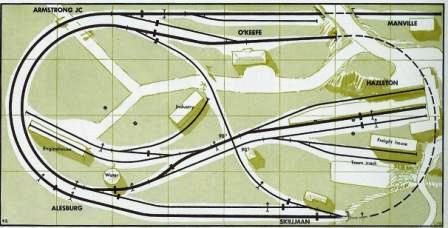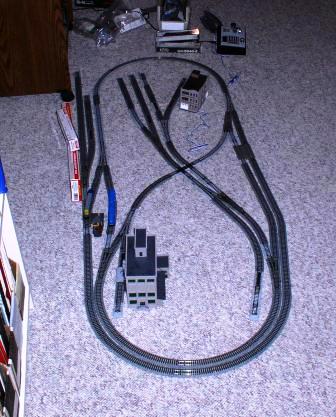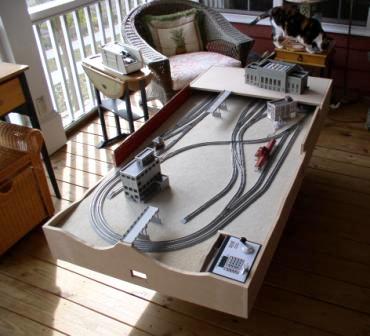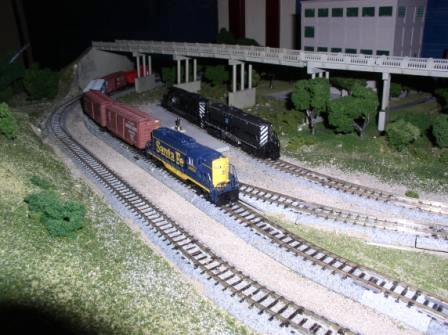Based upon a layout designed by the late, great John Armstrong which appears in the classic book, 101 Trackplans for Model Railroads [Kalmbach Publishing, 400-12012, still in print], this railroad combines different elements to offer varied model railroad operations.

At the center right of the railroad is the Union Passenger Station. From this station, trains can operate out & back, which is to say that a passenger train leaves the station, goes out onto the circular main line and eventually comes back into the station after passing through the reverse loop. Another passenger train can operate point to point, meaning that the train goes out of the station, operates along the circular main line and then goes into another station area, located at the upper right of the plan. The railroad also offers continuous running, with trains simply running on the circular main line, with some variety being introduced through operation on the different tracks. Trains also can stop at the suburban station located at the area identified as "Skillman". The Texas & Southwestern also can handle freight train operations, especially freight car forwarding, using individual destination waybills for freight cars being picked up at the interchange, located at the top right of the plan, and being delivered to the grain mill and the warehouse adjacent to the Union Station. These cars are later picked up and returned to the interchange, where they are exchanged for other cars. This allows you to exchange freight cars on the railroad, making for a variety of different colors and car types. Our industries primarily require covered hopper cars and box cars, but other car types such as tank cars can be used also. Armstrong’s original plan, named the Pennsylvania & Potomac, was drawn to fit in a 48” by 96” space in H0-scale. Although N-scale is about 50% of the proportion of H0, because of track geometry issues, this layout is not exactly ½ the size of the H0 railroad. As with any other model railroad, concessions have been made to the reality of actually building something. Dallas, Texas had many more tracks that we have built here, but the look and feel of the area has been captured. Here, the track plan is first set out to test for fit and arrangement:

The observant have already noted that we eliminated several tracks for the purposes of simplicity. Kato Unitrack shows its real utility here, with the track plan quickly snapped together and able to operate on a carpeted floor. Of course, we will be doing more than that. Here, the layout is fitted to its supporting frame of 1/2" MDF. The layout surface is covered with a sheet of HomasoteTM, a recycled paper product, which absorbs the noise of model trains rolling over the railroad. Building locations are still being determined at this point.

As with every model railroad, concessions to reality have been made. For one, the Dallas Union Station had considerably more tracks than the meager three of our railroad. The terminal building itself was to one side of the tracks, not above them as on our little pike. And, there are some other little concessions along the way because this is, after all, a model railroad. That said, what is important here is that a good model railroad captures the flavor of the place it represents, and, as we go along, little details will be added to make this world real. In short, the Texas & Southwestern is an interesting model railroad to operate, which helps draw the operator into this small world. Each side of our model railroad has a Universal Panel, which allows four or more operators to work this model railroad at one time. With one operator handling signals and track switch operations, there is enough capacity for three other operators to run trains, although each may have to wait for other trains, as it is with the prototype railroads.

Many thanks to Mr. Riley O'Connor for sharing the Texas & Southwestern with us!